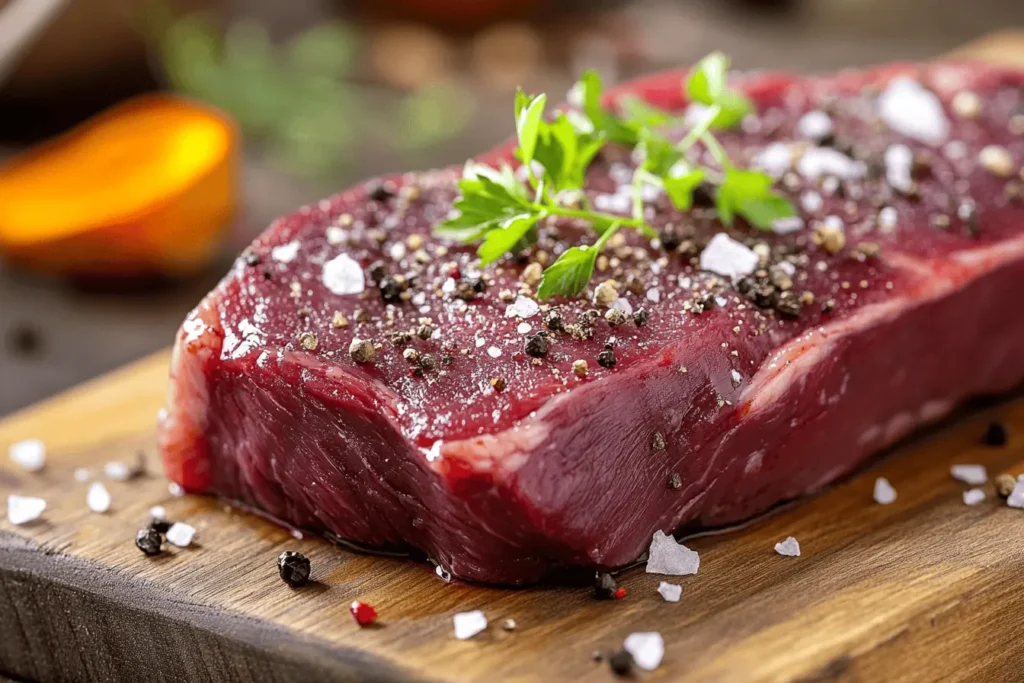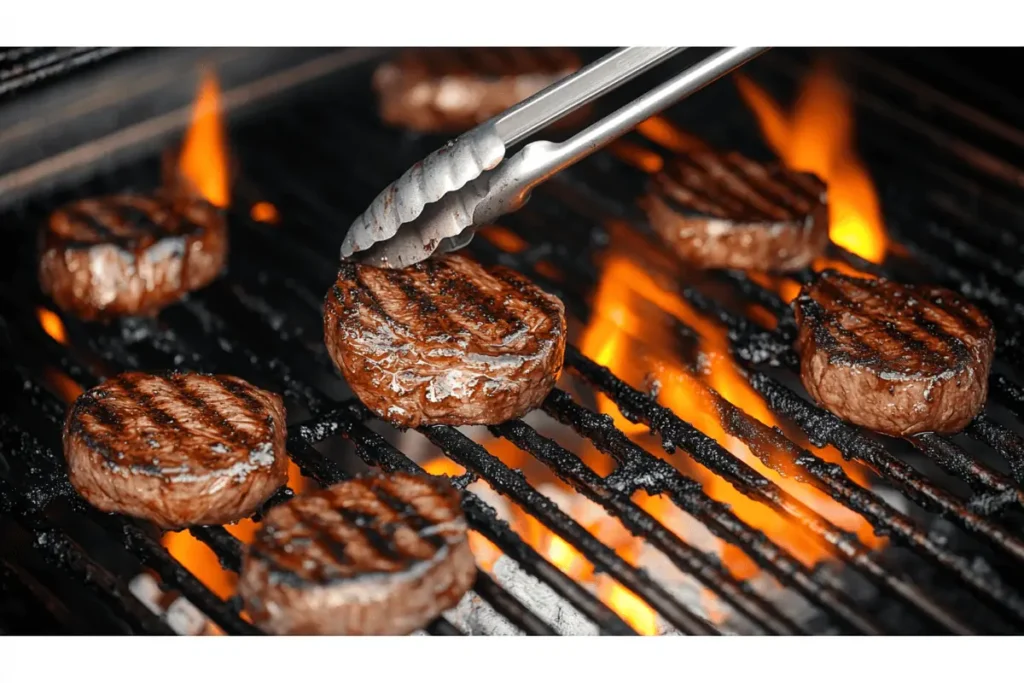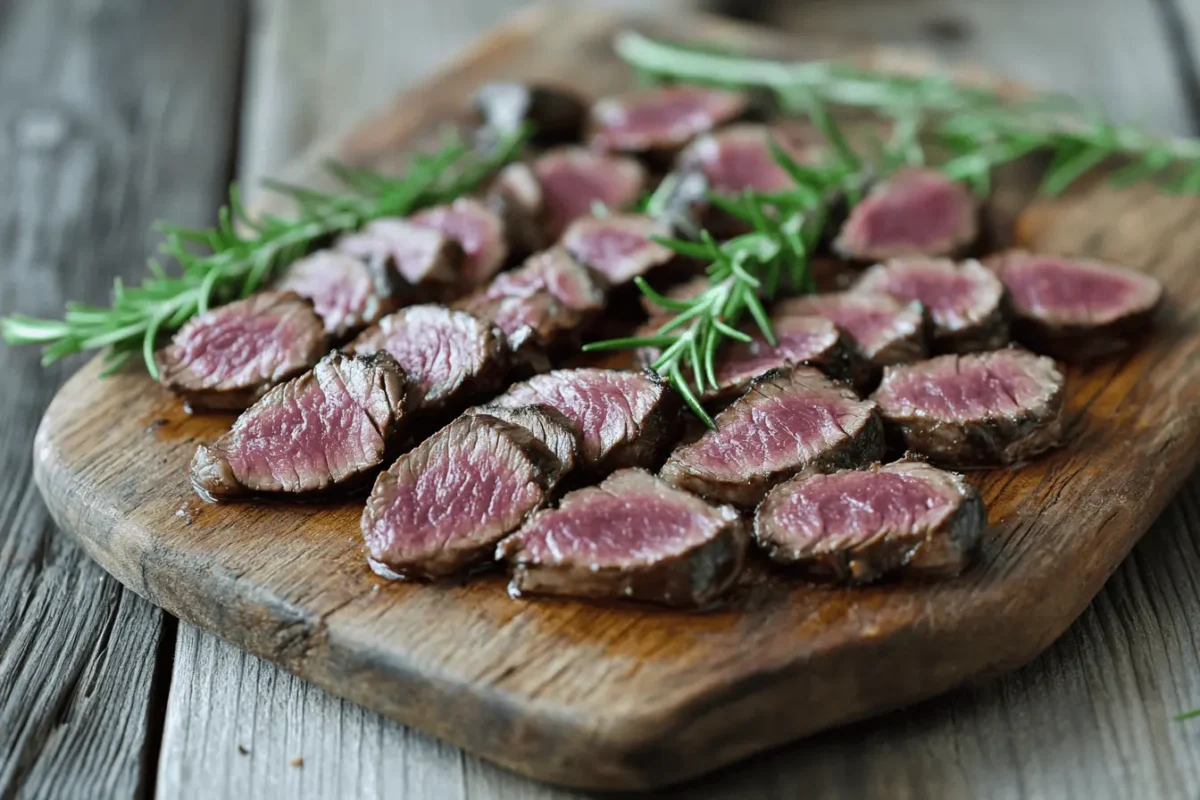Venison Backstrap cooking techniques often spark curiosity among home cooks. This prized cut, known for its tenderness and subtle, earthy flavors, can transform into a gourmet dish with the right approach. However, cooking venison backstrap requires patience and proper technique. Without guidance, it may turn tough or lose its natural richness.
This article guides you through Venison Backstrap cooking techniques suited for every skill level. You will learn about seasoning, marinating, grilling, pan-searing, roasting, and even sous vide methods. We will discuss how to avoid dryness, how to enhance flavor, and how to serve this lean meat in ways that impress family and guests. By the end, you will know everything needed to master this exceptional cut.
Table of Contents
Understanding Venison Backstrap
Venison backstrap, also known as deer loin, comes from the deer’s upper back. Its tenderness rivals high-quality beef steaks. However, venison contains less fat, making it leaner and prone to dryness if cooked incorrectly.
Although its flavor stands out on its own, the right cooking methods highlight its sweetness and subtle gamey notes. Therefore, learning Venison Backstrap cooking techniques helps you bring out these attributes. Understanding this lean nature encourages you to adopt gentle, careful cooking approaches.
In addition, venison backstrap often carries a mild, clean taste. It responds well to herbs, gentle spices, and careful seasoning. Perfectly cooked backstrap feels tender, juicy, and rich. With practice, you can achieve a texture as delicate as the finest steaks.
Preparing the Venison Backstrap
Before diving into Venison Backstrap cooking techniques, start with proper preparation. Handle the meat with care. Trim away silver skin and any tough connective tissue. This ensures a cleaner bite and more even cooking.
To do this:
- Use a sharp boning knife.
- Slide it under the silver skin and peel it away with gentle strokes.
- Remove any large pockets of connective tissue.
- Pat the meat dry with a paper towel to ensure good browning later.
In addition, ensure the meat has been stored properly. Keep it refrigerated and use it within recommended time frames. If frozen, thaw it in the fridge overnight, never at room temperature. Proper preparation lays the groundwork for successful Venison Backstrap cooking techniques.
Seasoning and Marinating Venison Backstrap
Seasoning venison backstrap enhances its natural taste. Since venison is lean, it can handle bold flavors, but start subtle. Salt and pepper provide a basic foundation. Herbs like rosemary, thyme, or juniper berries add depth. A hint of garlic or shallots contributes aroma and complexity.
For even more flavor, consider marinating. A good marinade can tenderize the meat and introduce complementary notes. Since venison is lean, adding oil to the marinade helps keep it moist. Wine, balsamic vinegar, or citrus juice provide acidity, brightening flavors. However, do not over-marinate. A few hours often suffice.

Choosing the Right Cooking Method
Selecting the right method can transform your meal when you explore Venison Backstrap cooking techniques. Each method imparts distinct flavors and textures.
Common methods include:
- Grilling: Direct heat caramelizes the surface.
- Pan-Searing: High heat forms a crust while keeping the interior juicy.
- Roasting: Gentle, even heat works well for larger pieces.
- Sous Vide: Precise temperature control ensures consistent doneness.
- Smoking: Adds complexity and depth over a slower period.
Your choice depends on personal preference, available equipment, and time. For a straightforward, delicious option, pan-searing provides control and simplicity. For an outdoor experience, grilling adds a smoky hint. Regardless of the method, pay attention to internal temperature to prevent overcooking.
Grilling Venison Backstrap
Grilling ranks among the popular Venison Backstrap cooking techniques because of the charred exterior and juicy interior. However, venison’s leanness means you must proceed with caution. Preheat the grill to medium-high. Lightly oil the grates to prevent sticking.
Steps for grilling:
- Season or marinate the backstrap.
- Pat it dry before placing it on the grill to achieve good sear marks.
- Grill over direct heat for a few minutes per side. Avoid overcooking.
- Move the meat to indirect heat if it needs more time.
- Use a meat thermometer to ensure proper doneness (about 130°F to 135°F for medium-rare).
Rest the grilled venison for several minutes before slicing. This allows juices to redistribute, ensuring every bite tastes succulent. Serve with roasted vegetables or a simple green salad to complement the smoky flavors.

Pan-Searing and Stovetop Techniques
Pan-searing provides control and simplicity. It is a versatile Venison Backstrap cooking technique ideal for smaller kitchens or when grilling is not an option. A cast-iron skillet works best due to its even heat distribution.
Steps for pan-searing:
- Preheat your skillet over medium-high heat.
- Add a tablespoon of high-smoke-point oil (like canola or grapeseed).
- Season the backstrap with salt, pepper, and herbs.
- Place it in the hot pan and sear each side for a few minutes.
- Reduce heat if the outside browns too quickly. Adjust timing as needed.
Aim for an internal temperature of about 130°F for medium-rare. Remove the backstrap from heat and let it rest under a loose foil tent. Slicing too soon releases valuable juices. Patience pays off, resulting in tender, flavorful slices.
For more stovetop techniques and how to achieve perfect sear, read How Long Can You Marinate Venison? which also provides insight into flavor absorption and timing.
Roasting in the Oven
Roasting suits larger pieces of backstrap. The dry, even heat surrounds the meat, resulting in uniform cooking. This method works best if you pre-sear the venison to develop a crust and then finish it in the oven.
Steps for roasting:
- Preheat your oven to about 375°F.
- Season the backstrap and sear it in a hot skillet for color.
- Transfer it to a roasting pan.
- Roast until the internal temperature reaches around 130°F.
- Let it rest for at least 10 minutes before carving.
Roasting pairs well with root vegetables or a pan sauce. Consider adding carrots, parsnips, or potatoes to the roasting pan. As venison roasts, the vegetables absorb savory juices, creating a complete meal in one pan.
Sous Vide for Perfect Doneness
Sous vide offers precise temperature control. It ensures even cooking throughout the backstrap. Although it requires specialized equipment, this Venison Backstrap cooking technique delivers reliable, tender results.
Steps for sous vide:
- Season the backstrap with salt, pepper, and herbs.
- Seal it in a vacuum bag with a bit of oil.
- Cook in a water bath at about 129°F for medium-rare.
- After the set time (1-2 hours), remove the meat and pat it dry.
- Quickly sear it in a hot pan for a nice crust.
Sous vide prevents overcooking by holding a precise temperature. The final sear adds flavor and texture. This method works well for those new to cooking venison or who value consistency.
Smoking and Low-and-Slow Methods
Smoking venison adds deep, complex flavors. Slow, gentle heat and wood smoke infuse richness. Although smoking takes longer, the reward is a tender, aromatic backstrap that guests admire.
Steps for smoking:
- Season with a dry rub or simple salt and pepper blend.
- Use hardwoods like oak, hickory, or apple for gentle smoke.
- Maintain a temperature around 225°F to 250°F in your smoker.
- Monitor internal temperature, aiming for about 130°F.
- Let it rest before slicing thinly against the grain.
Serve smoked venison thinly sliced as an appetizer or main course. Pair with bold sauces or fruit chutneys to balance the smoky profile.
Checking for Doneness
Determining doneness remains crucial in Venison Backstrap cooking techniques. Venison dries out when overcooked. Aim for medium-rare to medium. A good meat thermometer provides accuracy. Insert it into the thickest part of the backstrap.
- Rare: 120°F to 125°F (very pink, quite rare)
- Medium-rare: 130°F to 135°F (ideal balance of tenderness and flavor)
- Medium: 135°F to 140°F (still tender, slightly less juicy)
- Above 140°F: Risk of dryness and tougher texture
When you achieve the desired temperature, remove the meat from heat and let it rest. Resting ensures juicy slices and an enjoyable texture.
Resting and Slicing for Maximum Tenderness
After cooking, resting is not optional. It is essential. During rest, the meat’s fibers relax and reabsorb juices. If you slice too soon, those juices spill onto the cutting board, leaving dry meat.
Tips for resting:
- Tent the cooked venison with foil for about 5-10 minutes.
- Allow larger cuts to rest longer.
- Slice against the grain to shorten muscle fibers and promote tenderness.
This simple step can turn a good dish into a great one. Patience pays off. Once rested, slice the backstrap into medallions or thin strips, depending on your serving style.
Adding Sauces and Accompaniments
While Venison Backstrap cooking techniques matter, thoughtful accompaniments enhance the meal. Consider a pan sauce made from the meat’s drippings, butter, and a splash of wine. A simple red wine reduction or a mushroom sauce complements venison’s earthy character.
Side dishes also matter. Roasted vegetables, creamy mashed potatoes, or wild rice pair naturally. For a lighter option, serve a crisp, green salad. Balancing flavors ensures the venison remains the star.
Avoiding Common Mistakes
Like any culinary pursuit, Venison Backstrap cooking techniques come with potential pitfalls. Avoid these common mistakes:
- Overcooking: Venison is lean, so cook to medium-rare or medium.
- Skipping Rest: Without rest, juices escape, resulting in dryness.
- Heavy Seasoning: Start with subtle flavors. Add more as you learn your preferences.
- Ignoring Temperature: Always use a thermometer for best results.
With experience, these mistakes become less likely. Learning from trial and error refines your technique and builds confidence.
Storing and Reheating Leftovers
Leftover venison backstrap can remain tender if stored and reheated correctly. Slice it before refrigeration for easy portioning.
Storage tips:
- Wrap leftovers in airtight containers.
- Refrigerate promptly and use within 2-3 days.
- Freeze if you cannot consume soon, but use within a couple of months for best quality.
Reheating tips:
- Gently warm sliced venison in a low oven.
- Avoid microwaves, which can dry out the meat.
- Consider using leftover slices in sandwiches, salads, or stir-fries.
By treating leftovers with care, you can enjoy the fruits of your cooking again.
Experimenting with Flavors
Once you master basic Venison Backstrap cooking techniques, experiment with flavors. Try a coffee-and-cocoa rub for a unique crust. Explore marinades with soy sauce, ginger, or citrus zest. Add a hint of sweetness with maple syrup or honey.
Global flavors also shine. A Mediterranean herb rub, an Asian-inspired marinade, or a Southwest chili blend can transform the profile. With each experiment, track what worked and what did not. Over time, you will develop a personal signature approach to venison backstrap.
For guidance on pairing seasonings and herbs, read What seasonings go best with venison? That resource expands your flavor possibilities.
Serving Suggestions and Plating Ideas
Presentation enhances the dining experience. Slice venison backstrap on a bias and arrange it on a warm platter. Drizzle a pan sauce around it, not over it, to preserve texture. Garnish with fresh herbs for color contrast.
Pair it with sides that complement the chosen cooking method. Grilled backstrap pairs well with grilled vegetables. A roasted loin works nicely with mashed root vegetables. A sous vide preparation might shine with a delicate herb salad and a light sauce.
Textures also matter. Crisp vegetables or crunchy toppings balance venison’s tender bite. Integrate contrasting textures to elevate the meal beyond simple meat and potatoes.
Venison Backstrap in Different Cuisines
Venison fits into many culinary traditions:
- In European kitchens, it pairs with juniper, red wine, and wild mushrooms.
- In North America, smoky, charred preparations dominate.
- In Asian-inspired dishes, soy sauce, ginger, and sesame oil add intrigue.
Consider the origin of your venison. Wild flavors may suggest certain herbs or marinades. Embrace the opportunity to give a regional twist, or explore cross-cultural fusions that surprise and delight.
Health and Nutritional Considerations
Venison is lean and high in protein. It contains essential nutrients like iron and B vitamins. Proper cooking techniques preserve its nutritional value. Avoid overcooking to maintain juiciness and prevent nutrient loss.
Serving venison with vegetables and whole grains creates a balanced meal. Incorporate leafy greens, roasted beets, or a whole-grain side. This approach supports a healthful dietary pattern while indulging in a gourmet protein source.
Venison Backstrap for Special Occasions
Venison backstrap stands out as a premium choice for holidays, celebrations, or special dinners. Its unique flavor sets it apart from everyday cuts. Impress guests by showcasing advanced Venison Backstrap cooking techniques like sous vide finishing with a torch for extra color.
Plan your menu around the venison. Complement it with refined sides or a select bottle of wine. With a bit of effort, you can create a memorable experience that highlights your culinary skill.
Ethical and Sourcing Considerations
Sourcing venison ethically contributes to a responsible food system. Many hunters harvest venison from well-managed game populations. This ensures minimal environmental impact. If you do not hunt, consider sourcing venison from reputable farmers who prioritize animal welfare.
Understanding where your meat comes from adds meaning to the meal. You support sustainable practices and enjoy a product that reflects natural diets and environments.
Frequently Asked Questions
What is the best way to cook back straps of a deer?
The best way depends on your taste and tools. However, many prefer pan-searing or grilling. These methods create a flavorful crust while keeping the interior tender. Achieving a medium-rare internal temperature (about 130°F) ensures a juicy bite. Experiment and find which method delivers the flavors and textures you love.
Should you soak a deer backstrap before cooking?
oaking is optional. Some cooks soak backstrap in milk or a mild brine to reduce gamey notes. However, it is not always necessary. Proper trimming, seasoning, and correct cooking methods often suffice. If you choose to soak, limit the time and rinse before cooking.
For more on soaking, consider reading What’s the Best Thing to Soak Deer Meat In? for detailed guidance.
How do you cook venison so it’s tender?
Keep cooking times short to avoid dryness. Aim for medium-rare doneness. Rest the meat after cooking to let juices redistribute. Consider marinating or using a sous vide approach for consistent results. Proper slicing against the grain also helps. With these steps, your venison remains tender and juicy.
Why is my deer backstrap tough?
Overcooking often causes toughness. Venison is lean, so temperatures above medium can dry it out. Also, not resting the meat can lead to dryness. Another factor may be incorrect slicing. Always slice against the grain to shorten the muscle fibers. Adjust your technique and try again to achieve a more tender outcome.

